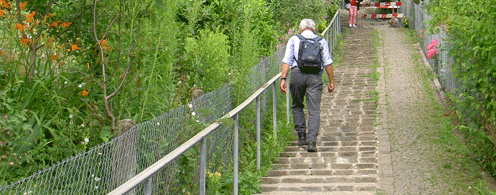
News
Autonomous vehicles: Dystopia or utopia for pedestrians?

Autonomous vehicles have the potential of a distributive technology. Their introduction will probably change our mobility behavior as much as the railway and later the automobile did. From the point of view of pedestrians, the question is whether it will improve or worsen the conditions for walking. It is especially difficult to predict correctly in this state. In two scenarios a dream world and a horror world can be described; they show how negative or positive the current development can be for the walkers.
Dystopia: The end of walking
No matter how we move: The first and the last stage of the way is always on walking. The world of autonomous vehicles could change this. Tesla cars can already drive independently on certain routes (mainly overland and on highways). Future updates could, for example, implement the ability for the car to search for a parking lot on its own. It offers the comfort of a private limousine with a driver. Owners of such cars will no longer have to walk from the parking lot to their destination. Because these vehicles have difficulties when people get in their way, the powerful vehicle manufacturers and their mainly wealthy customers will do everything in their power to ensure that pedestrians and cyclists do not get in the way of autonomous vehicles. Since these car owners hardly move on foot any more, there is no disadvantage for them. This lowers the complexity of allowing vehicles to drive completely autonomously.
Of course, parents in such a world don’t want their children to walk. So they buy a car for their child. As a consequence, the demand for parking space is increasing sharply. The sidewalks are reduced to a minimum or completely removed. Walking on the street is punished with heavy penalties. Only those who cannot afford their own vehicle will be walking anyway.
Utopia: New freedom for pedestrians
The path to a better future for pedestrians begins today – not with private vehicles, which are becoming more and more independent, but with a revolution in local public transport in rural areas. Postauto Schweiz tested autonomous minibuses in the city of Sion, which will serve as shuttle services at low speeds and as feeder buses for the major postal bus lines. With such buses, public transport in rural areas can be provided cost-effectively and on a high service level. As a result, the rate of motorization in rural areas is falling. Car sharing providers will convert their fleets to autonomous vehicles. Since such vehicles are cheaper than owning your own car, but offer the comfort of a limousine service, almost nobody owns a car anymore. Autonomous car-sharing cars are driving most of the times, the demand for parking lots is decreasing. So parking space will be transformed into public parks.
The autonomous vehicles, like the Google car today, will drive relatively slowly. To prevent accidents, they will be programmed that they always adapt the speed to the conditions – a requirement that people regularly overestimate. In order to ensure safe operation, these vehicles stop immediately in the case of technical malfunction. The passenger is picked up a few minutes later by a replacement vehicle and the car can be towed away. This means that pedestrians can cross the road safely anywhere without worrying about their safety.
Cargo transportation is carried out in its own underground system with long conveyor belts, where the loads circulate independently at constant speed. At central loading points the goods come to the surface and are distributed in the city by autonomous delivery vans and cargo bikes.
As the use of autonomous cars costs money, walking and cycling will be popular for short distances. In urban areas and on longer distances, autonomous buses, trams and trains will be used for cost reasons and to save time.
Conclusion
Whether the future reality will become more utopia or dystopia cannot be predicted yet. The following rules lead to a positive future for pedestrians:
- The parking of vehicles must cost the same as other uses in the relevant location.
- The sidewalk is a nogo area for autonomous vehicles. The have to driving on the road.
- Autonomous vehicles must be able to operate safely under the given circumstances. Autonomous cars must comply with today’s traffic rules.The infrastructure and marking shall not be adapted. In particular, no additional elements may be introduced to separate the sidewalks from the road.
- The manufacturer is liable for accidents and damage, if the vehicle is driving autonomous. For vehicles which can be driven both autonomously and manually, it shall be prevented that the mode can be changed while driving. It must be clear at all times whether man or machine is responsible.
- If a vehicle can no longer operate safely, it shall establish a safe condition (drive to the right border and stop)
